Physical Address
304 North Cardinal St.
Dorchester Center, MA 02124
Adenoid basal carcinoma (adenoid basal epithelioma) is composed of bland, uniform, basaloid cells arranged in nests with a variable amount of glandular and squamous differentiation. Based on their favorable outcome, there is a proposal to designate this tumor as ‘epithelioma,’ rather than carcinoma.
Adenoid basal carcinoma (epithelioma) accounts for less than 1% of cervical cancers and usually develops in postmenopausal women with a median age of 66.5 years and a wide age range, from 19 to 91 years. Most patients are asymptomatic and the tumor is frequently an incidental finding in a surgical specimen obtained after the diagnosis of high-grade squamous intraepithelial lesion on a Pap smear. In rare cases, patients can complain of vaginal bleeding, hematuria, or dysuria. The tumor appears to arise from reserve cells and is usually associated with human papillomavirus (HPV) 16.
Grossly, the tumor is usually invisible; however, induration, erosion, ulceration, and abnormalities of the cervical mucosa have been described in rare cases. Adenoid basal carcinoma (epithelioma) is composed of multiple, small, round to oval nests of bland, uniform, basaloid cells with peripheral palisading ( Figures 13.1 and 13.2 ). The tumor nests are haphazardly distributed in the cervical stroma without eliciting a desmoplastic response although focal edema and mild chronic inflammation may be seen. The tumor typically does not reach the surface of the endocervical canal; however, occasionally it appears in continuity with an overlying dysplastic squamous epithelium. Clearing of the cytoplasm due to the accumulation of glycogen may be seen. There is a variable degree of glandular and squamous differentiation ( Figure 13.3 ). The former is characterized by the presence of columnar or cuboidal cells with bland nuclei surrounding a distinct lumen while the latter shows bland squamous cells in the center of the nests with preservation of a peripheral rim of basaloid cells. Occasionally, a cribriform pattern can be noted. The mitotic index is usually low, although it may vary from 0 to 9 mitoses per 10 high power fields (HPFs). There is no necrosis or lymphovascular or perineural invasion. Although the tumor is typically associated with a high-grade squamous intraepithelial lesion, rarely, it can be associated with a superficially or frankly invasive squamous carcinoma, adenoid cystic carcinoma, adenosquamous carcinoma, clear cell carcinoma, neuroendocrine carcinoma, or carcinosarcoma.
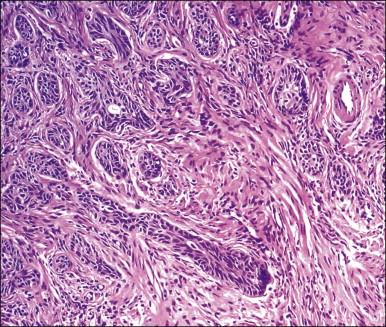
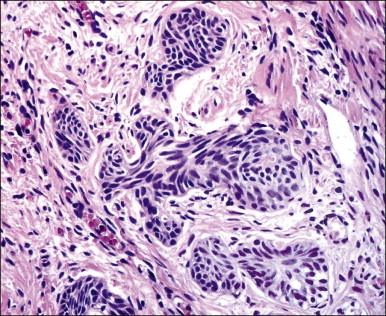
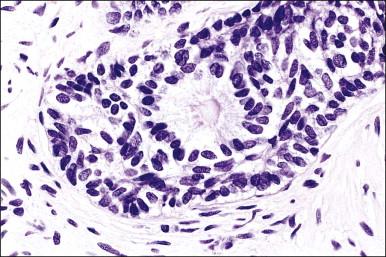
Adenoid basal carcinoma (epithelioma) is usually immunoreactive for keratin AE1/AE3, CK902 (against cytokeratin 8 and 18), epithelial membrane antigen (EMA), carcinoembryonic antigen (CEA), CAM 5.2, p16, p53, and p63. S-100 can be positive in a few cases. A limited number of cases of adenoid basal carcinoma (epithelioma) has been tested for CD117 (c-kit) and found to be negative.
Adenoid basal hyperplasia is a superficial lesion with epithelial nests smaller than those seen in adenoid basal carcinoma (epithelioma). The nests reside within 0.5 mm of the basement membrane of the overlying or adjacent epithelium and are connected to it.
Adenoid cystic carcinoma tends to produce symptoms and a grossly visible mass. Microscopically, it contains tumor nests that are larger than those seen in adenoid basal carcinoma (epithelioma) and characteristically show a cribriform pattern containing either amorphous, hyaline, eosinophilic basement membrane-like material, or basophilic mucinous or eosinophilic secretion. Necrosis and stromal changes are often seen as well as lymphovascular invasion.
Squamous carcinoma can represent a diagnostic difficulty since adenoid basal carcinoma (epithelioma) can have florid squamous metaplasia with marked expansion of the tumor nests, thus mimicking an invasive squamous carcinoma. In addition, focal dysplastic changes can be noted in the areas of squamous metaplasia. Recognition of a residual rim of bland basaloid cells, which can be highlighted with the use of CAM 5.2 immunoreaction, will facilitate the proper identification of adenoid basal carcinoma (epithelioma) with extensive squamous metaplasia.
Basaloid squamous carcinoma, a rare type of cervical tumor, usually produces a symptomatic tumor mass. Microscopically, this tumor is composed of moderately pleomorphic, basaloid cells arranged in nests and cords. There is also peripheral palisading. Mitotic activity and necrosis are conspicuous. Larger cells with eosinophilic cytoplasm as well as a cribriform pattern can be seen. Hyalinization or myxoid change of the stroma is also common.
Morphologically pure adenoid basal carcinomas (epitheliomas) behave in a benign fashion without metastases to lymph nodes or other sites, local recurrences, or death. Microscopic examination of the entire tumor is necessary to exclude the presence of an associated neoplasm that could have an adverse impact on the prognosis. Cases of morphologically pure adenoid basal carcinoma (epithelioma) are treated with a loop electrosurgical excision procedure or cold knife cone with negative margins. In cases where the neoplasm extends to the margins, a comment should be included in the report about the possible association with another tumor type that could affect the prognosis.
Cervical adenoid cystic carcinoma is a neoplasm with histologic features mimicking those of similar tumors of the salivary glands and upper respiratory tract.
This tumor is rare and mostly seen in postmenopausal women (mean age, 72 years), but it is occasionally detected in younger women in the third or fourth decades of life. Uterine bleeding is the most common presentation with a rare case diagnosed incidentally. This neoplasm appears to originate from reserve cells and is usually associated with HPV 16.
The tumor has a variable appearance from small polypoid lesions to large exophytic, friable masses or deeply invasive endophytic tumors. Microscopically, it is composed of mildly pleomorphic basaloid cells arranged in nests, sheets, cords, and trabeculae. Clear cell changes may be present. A distinct cribriform pattern containing either an amorphous hyaline eosinophilic basement membrane-like material or basophilic mucinous or eosinophilic secretion is usually seen ( Figure 13.4 ). Mitotic activity is variable, ranging from scanty to very high. Necrosis is often present and extensive. Stromal changes are typically prominent, ranging from hyalinization to myxoid or fibroblastic change. The solid variant lacks the typical cribriform pattern, but the tumor is recognized by the presence of abundant periodic acid–Schiff (PAS)-positive basement membrane material around the tumor cells that grow in solid nests, cords, and trabeculae. Small foci of squamous differentiation may be seen. Adenoid cystic carcinoma can be associated with adenoid basal carcinoma (epithelioma), in situ or invasive squamous cell carcinoma, adenosquamous carcinoma, or adenocarcinoma. Adenoid cystic carcinoma tends to involve lymphovascular spaces and develops lymph node metastasis early.
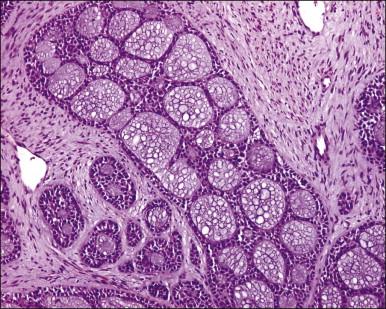
Tumor cells are reactive for wide spectrum cytokeratin (CK), CAM 5.2, and EMA. S-100 protein reactivity occurs in some cases while others are unreactive or just focally and weakly reactive. A rare case of cervical adenoid cystic carcinoma has been tested for CD117 (c-kit) and was found to be strongly reactive in approximately 5% of the cells. This finding does not compare with the common expression of CD117 (c-kit) in adenoid cystic carcinoma of the salivary glands, which is seen in 80–100% of cases.
Adenoid cystic carcinoma is an aggressive tumor. In one series, nearly half of the patients died of local recurrence or metastatic disease within 8 months to 8 years of diagnosis. Treatment options include radiotherapy, surgery, surgery and adjuvant radiotherapy, or chemotherapy.
Neuroendocrine tumors of the uterine cervix are rare. According to the nomenclature system proposed in 1997 by the College of American Pathologists and the National Cancer Institute, they are classified as typical (classic) carcinoid tumors, atypical carcinoid tumors, small cell neuroendocrine carcinomas, and large cell neuroendocrine carcinomas. These tumors may originate from cells containing neuroendocrine granules, seen in 20% of normal cervices, or from reserve cells.
Additionally, an association with HPV 18 or 16 has been described in atypical carcinoids, small cell neuroendocrine carcinoma, and large cell neuroendocrine carcinoma.
The least common of the neuroendocrine tumors is composed of uniform cells forming nests, trabeculae, cords, or glands. The chromatin is finely granular. Mitoses are rare (at the most 3 mitoses per 10 HPFs) and there is no necrosis ( Figure 13.5 ). Immunohistochemical studies show that the tumor cells are positive for neuroendocrine markers such as neuron-specific enolase, CD56, chromogranin, or synaptophysin.
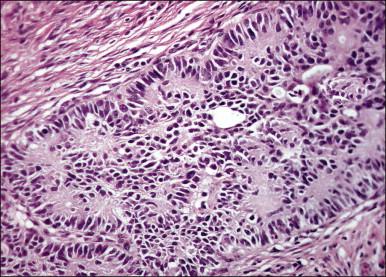
The experience with this tumor, when arising in the cervix, is limited to delineating its behavior and optimal treatment.
The second least common of the neuroendocrine tumors is distinguished from the typical (classic) carcinoid on the basis of a mitotic index above 3 mitoses per 10 HPFs (but fewer than 10 mitoses per 10 HPFs) and/or necrosis, usually comedo-type ( Figures 13.6 and 13.7 ). Immunohistochemical studies show that the tumor cells are positive for the neuroendocrine markers listed above. Similarly to the typical carcinoid tumor, the experience with atypical carcinoid tumor of the cervix is limited. Therefore, its behavior and optimal treatment are undetermined.
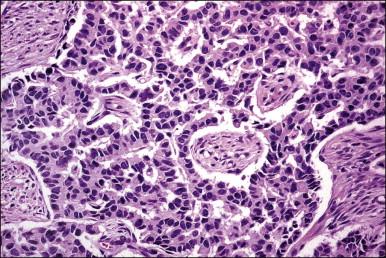
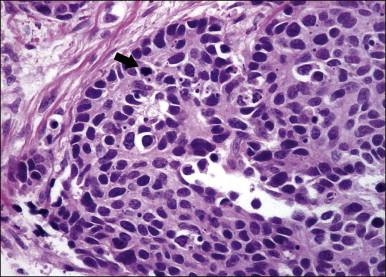
This tumor is composed of uniform small cells with a high nuclear to cytoplasmic ratio, similar to small cell carcinoma of the lung.
This tumor accounts for less than 5% of the cervical carcinomas; however, it represents the most frequent neuroendocrine neoplasm of the uterine cervix. Patients' ages range from 20 to 87 years (mean, 45 years). Vaginal bleeding is the most common symptom followed by pain. A rare case has been detected in an abnormal Pap smear. Occasionally, patients have developed paraneoplastic syndromes, including Cushing's syndrome, hypoglycemia, inappropriate antidiuretic hormone production, carcinoid syndrome, and Eaton–Lambert syndrome. Most tumors are International Federation of Gynecology and Obstetrics (FIGO) stage I or II.
Become a Clinical Tree membership for Full access and enjoy Unlimited articles
If you are a member. Log in here